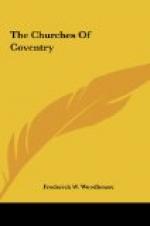But these gifts were not sufficient to support the church and its services, so that the latter were irregular and repairs were neglected. In 1608 Mayor Hancox procured the delivery of a Saturday lecture “for the better fitting of the people for the Sabbath.” In 1641 Simon Norton, alderman, left property to his son Thomas, on trust, the condition being that if at any time St. John’s should become a parish church, he or his heirs should pay L13 6_s_. 8_d_. to the minister out of rents of lands in Coundon, and also the tithes of lands in Clifton.
Prisoners from the Scottish army being quartered on the city in 1647, many were confined in this church and wrought much damage and desecration. From this time services were only occasionally held, until 1734, when an Act of Parliament was obtained making it a Parish Church, appointing a district to it and enabling the Master and Usher of the Free Grammar School to be Rector and Lecturer of the church. The mayor, bailiffs, and commonalty were made patrons, but in 1835, these arrangements having failed to work satisfactorily, the patronage was transferred to trustees who acted as managers of the school and in 1864 the lectureship was abolished, the rectory was severed from the office of Head Master and the Trustees of the school were charged with a payment of L200 per annum towards the stipend of the Rector. In 1874 the advowson was sold to a private person. A great deal of restoration, justifiable and otherwise, has taken place, the decay of the local sandstone having made large repairs necessary. In 1861 much renewal of the external stone work was carried out. Unfortunately shortsighted ideas of economy led to the use of the same poor stone and much has recently had to be done over again, this time with the harder Runcorn stone used also at St. Michael’s. The interior was restored in 1875, galleries erected in 1735 and 1838, and high pews were removed, the floor, which had been raised three feet, lowered, the lantern stage of the tower opened up by removing a ringing floor and a light iron gallery above the tower arches provided for the ringers. The original groined ceiling has thus been made visible from below.
THE EXTERIOR
Although small in area compared with the other churches, both exterior and interior give an impression of size and dignity which does not belong to many much larger buildings. In the exterior this is no doubt due to the pseudo-cruciform arrangement, the bold central tower and the height of the main roof, which would have appeared even greater had the roadways not been so much raised.




